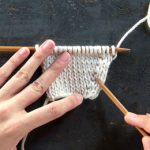Knit Two Together (k2tog)
Chances are that if you’re making a hat, mittens, socks, or a sweater, you’re going to be decreasing. Chances are even better that one of the decreases you’ll be using is a knit two together (k2tog). The most popular right-leaning decrease, k2tog is a knitting essential. It’s also super easy! The basic gist of a k2tog is that you make a normal knit stitch, except instead of inserting the right needle into one stitch, you insert it into two. Just like it sounds, you really do just knit two together! Here’s a video of how to work this stitch, followed by the same thing written out…
To work a k2tog, insert the tip of the right needle into the front leg of the second stitch on the left needle, just as if you were making a normal knit stitch. Keep going with the right needle and slip it into the first stitch on the needle, again, as if to knit. The front legs of both stitches are now on the right needle. Next, wrap the working yarn counter clockwise around the right needle. Pull the yarn through both stitches and allow them to fall off the left needle, just as you would a single stitch.
Ta da! Two stitches are now one: a right-leaning stitch on the right needle. A k2tog’s right-leaning nature comes in handy when you want decreases to follow the slope of something like a raglan line or a thumb gusset, which leads us to k2tog’s left-leaning buddy, the slip slip knit (ssk). It’ll come in handy in those situations and you can learn all about it right here!









I'm so excited for these new videos. I'm quite new to knitting and self taught. I have just been doing basic stitches K1 P1 and would like to venture into trying some new stitches. It would be nice to have a little more explanation for each stitch if possible. For example, the K2TOG, why did you do the K2TOG four stitches from the end…instead of just the last two stitches? will you explain please? Love your store love your blog! you guys are the best. Thanks so much!
Hi cricks-
We did our k2tog two stitches in from the edge just so that it would be easier for viewers to see.
In a pattern when you are instructed to do a K2tog it will always tell you where to place it. There is no right or wrong place to do it, you just do it where you need a simple decrease.
Thank you so much for writing in and please let us know if you have any more questions!
Molly
Thank you for a clear tutorial on this stitch k2tog.
Thank you it’s really helpful when I see a video.
Thank you! I love that you provide both a video and a text explanation of this technique.
Hi Dawn,
We’re so glad that you’re finding the tutorials helpful! Thank you for your kind words, and let us know if you have any questions!
Warmly,
Kelsey
Hey!
I find it hard to pass through 2 “loops” in order to knit 2 together.
I wonder… would it work the same if I were to slip 2 stitches purl-wise and then knit? Basically like a ssk but with slip purl-wise twice and then knit, rather than slip-knit wise, slip-purl wise, knit? In my brain it should be the same result of a k2tog but I’m not sure.
Thanks for the video (and the patterns)!
Hi Anna,
Thanks for reaching out! An ssk or ssp is a bit different from a k2tog as a whole, even if you slip 2 purlwise it will result in a right-leaning decrease and a knit 2 together leans left. If your pattern calls for a k2tog you will want to stick with that otherwise your decreases will not lean the correct way!
I hope this clears things up!
Gianna
thanks so much, Gianna!
Makes total sense
Me too. I find it hard to get the needle into two stitches. I guess I tend to knit too tight. I am knitting a diagonal dish cloth. I am thinking what a problem this would be on a diagonal blanket. Maybe not such a good project for me at this stage. Or pick a more flexible yarn than cotton.